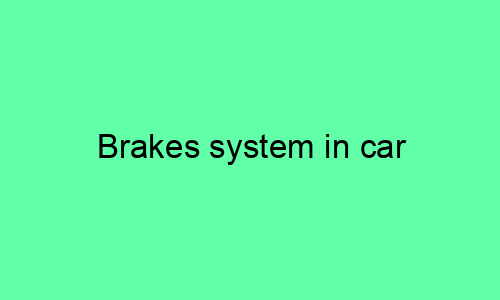## Brakes System in Car
### Introduction
Keeping our vehicles, especially cars, in proper working condition is crucial for ensuring safety and reducing the risk of accidents. Among the essential components of a car is the braking system, which plays a vital role in controlling the vehicle’s speed and bringing it to a halt. In this post, we will explore the components, working principles, types, and maintenance requirements of a car’s brake system.
### Components of a Brake System
A car’s brake system consists of several key components:
1. **Brake Master Cylinder:** Conveys hydraulic pressure from the brake pedal to the other components.
2. **Brake Calipers:** Hydraulically actuated devices that squeeze brake pads against brake rotors, creating friction to slow down the wheels.
3. **Brake Rotors:** Metal discs attached to the wheels that rotate with them and provide the surface against which brake pads apply friction.
4. **Brake Pads:** Friction materials that are compressed against brake rotors to create friction and slow down the wheels.
5. **Brake Hoses and Lines:** Flexible or rigid conduits that transmit hydraulic fluid from the brake master cylinder to the brake calipers.
6. **Brake Pedal:** The mechanical interface through which the driver actuates the brake system.
### Working Principles
The working principles of a car’s brake system are based on hydraulics. When the brake pedal is depressed, the brake master cylinder converts the mechanical force applied by the driver into hydraulic pressure. This pressure is then transmitted through brake hoses and lines to the brake calipers. The pressurized fluid forces the brake calipers to squeeze the brake pads against the brake rotors, creating friction that decelerates the wheels and ultimately slows down the vehicle.
### Types of Brake Systems
There are two main types of brake systems used in cars:
1. **Drum Brakes:** In drum brakes, brake shoes are pressed against the inside of a rotating drum attached to the wheel. Friction between the brake shoes and the drum slows down the wheel.
2. **Disc Brakes:** Disc brakes are more prevalent in modern cars and use brake calipers to squeeze brake pads against a rotating brake rotor. Disc brakes offer better stopping power and heat dissipation than drum brakes.
### Maintenance Requirements
Regular maintenance is crucial to ensure optimal performance and safety of a car’s brake system. Here are some essential maintenance tips:
1. **Brake Fluid Inspection and Replacement:** Brake fluid should be checked and replaced regularly, typically every two years or 20,000 miles. Low brake fluid levels can indicate leaks or reduced system effectiveness.
2. **Brake Pad Replacement:** Brake pads wear down over time due to friction, reducing their effectiveness. Inspect brake pads regularly and replace them when they reach a minimum recommended thickness.
3. **Brake Rotor Inspection and Resurfacing:** Brake rotors may develop uneven wear or warping, which can result in vibrations or reduced braking performance. If necessary, rotors can be resurfaced to restore a smooth surface.
4. **Brake Hose and Line Inspection:** Inspect brake hoses and lines for cracks, leaks, or other damage. Damaged hoses or lines can compromise the entire brake system.
5. **Parking Brake Inspection and Adjustment:** The parking brake, which is often a mechanical system, should be inspected and adjusted regularly to ensure proper engagement and release.
### Importance of a Well-Maintained Brake System
A well-maintained brake system is essential for several reasons:
1. **Safety:** Properly functioning brakes are crucial for safe driving, allowing drivers to control the speed of their vehicles effectively and avoid accidents.
2. **Reduced Stopping Distances:** Worn or damaged brake components can significantly increase stopping distances, increasing the risk of collisions.
3. **Consistency and Control:** A well-maintained brake system provides consistent and reliable performance, giving drivers confidence and control behind the wheel.
4. **Prevention of Costly Repairs:** Regular maintenance helps prevent major brake system failures, which can be expensive to repair or replace.
### Conclusion
The brake system in a car is a crucial component that ensures safety and control. By understanding its components, working principles, types, and maintenance requirements, drivers can make informed decisions about maintaining their vehicles and reducing the risk of brake-related accidents. Regular maintenance is essential to ensure optimal performance, longevity, and safety of a car’s brake system, providing peace of mind and enhancing the overall driving experience.






